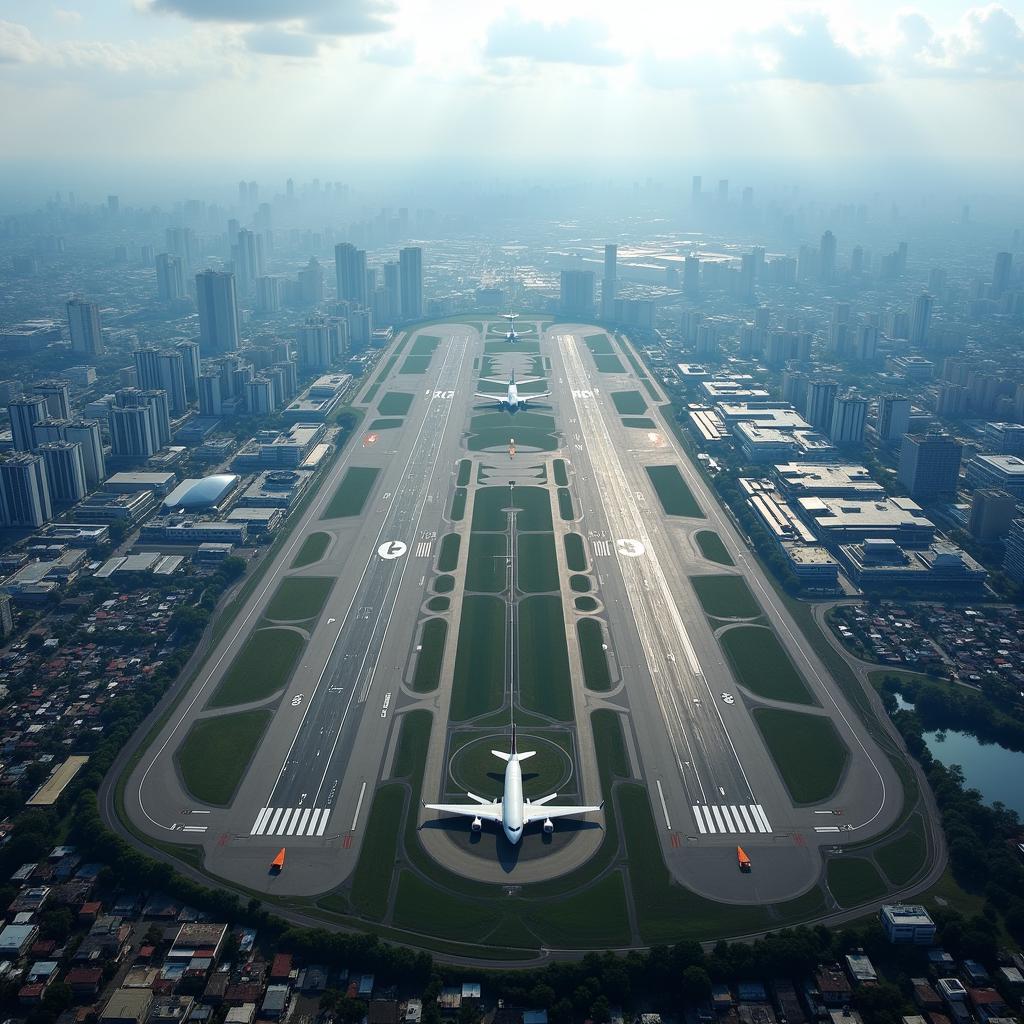Mumbai Airport, officially known as Chhatrapati Shivaji Maharaj International Airport (CSMIA), is a bustling hub of air traffic in India. Many travellers planning their journey through this major airport might wonder about the Aai Mumbai Airport Height. While the question of an airport’s height might seem unusual at first, understanding its elevation plays a crucial role in various aspects of aviation, from flight planning to infrastructure development.
 Mumbai Airport Aerial View
Mumbai Airport Aerial View
Unraveling the Numbers: Elevation and its Significance
The height of an airport, specifically its elevation above sea level, is a key factor in determining various operational parameters. AAI Mumbai Airport sits at an elevation of 39 feet, or 12 meters, above sea level. This seemingly simple figure has significant implications for aircraft performance, particularly during takeoff and landing.
How Elevation Impacts Aircraft Operations at AAI Mumbai Airport
The higher the elevation, the thinner the air becomes. Thinner air means less air density, which directly affects:
-
Lift Generation: Aircraft require a certain amount of air density to generate enough lift for takeoff. At higher elevations like that of AAI Mumbai Airport, aircraft might need a longer takeoff run to achieve the required lift.
-
Engine Performance: Aircraft engines, especially those powered by jet turbines, can experience a decrease in performance at higher elevations due to reduced air intake.
-
Landing Distance: Landing at a higher elevation requires careful calculations as thinner air can lead to increased landing distances.
 Mumbai Airport Runway
Mumbai Airport Runway
AAI Mumbai Airport and its Unique Geographic Location
Beyond its elevation, AAI Mumbai Airport’s geographical location on the western coast of India also plays a role in its operational considerations.
-
Proximity to the Sea: The airport’s proximity to the Arabian Sea means that humidity levels can significantly influence air density. Higher humidity can further reduce air density, impacting aircraft performance.
-
Weather Patterns: Mumbai experiences distinct monsoon seasons with heavy rainfall. These weather patterns necessitate careful monitoring and adjustments to flight operations, taking into account factors like visibility and wind conditions.
Navigating the Skies: How AAI Manages Operations
The Airports Authority of India (AAI) employs various measures to ensure safe and efficient flight operations at Mumbai Airport, taking its elevation and geographic location into account.
-
Runway Length: AAI Mumbai Airport has two runways, both designed with sufficient length to accommodate the takeoff and landing requirements of aircraft operating at its elevation.
-
Air Traffic Control: The airport’s sophisticated air traffic control system plays a vital role in managing aircraft movements, ensuring safe separation and efficient traffic flow.
-
Weather Monitoring: AAI closely monitors weather conditions, providing real-time updates and forecasts to pilots to aid in flight planning and decision-making.
Beyond the Numbers: AAI Mumbai Airport’s Vital Role
Understanding the AAI Mumbai Airport height provides a glimpse into the complex world of aviation and the crucial role that elevation plays. AAI’s proactive approach to managing operations at this important airport ensures the smooth flow of air traffic while prioritizing safety and efficiency.
FAQ
1. What is the elevation of AAI Mumbai Airport?
AAI Mumbai Airport is located 39 feet (12 meters) above sea level.
2. How does elevation impact aircraft performance?
Higher elevations have thinner air, which can affect an aircraft’s ability to generate lift and impact engine performance.
3. What measures does AAI take to ensure safe operations at Mumbai Airport?
AAI employs measures like long runways, advanced air traffic control, and comprehensive weather monitoring to ensure safe and efficient flight operations.
4. Does Mumbai’s coastal location affect airport operations?
Yes, Mumbai’s proximity to the sea and its distinct monsoon seasons can influence air density and weather conditions, requiring careful consideration for flight operations.
5. Where can I find information about AAI Mumbai Airport arrivals and departures?
You can find real-time updates on arrivals and departures at Mumbai Airport Arrival Status.
For further information on airport rankings in India and the Airports Authority of India, you can explore these resources:
- Airport Ranking in India
- AAI to Privatize Some Airports
- Kolkata Airport Authority
- 18 International Airports in India Owned by AAI
Need Assistance?
Contact our 24/7 customer support at +13089626264 or email us at [email protected]. You can also reach us at our office located at 404 Bothwell St, Oxford, NE 68967, USA.

